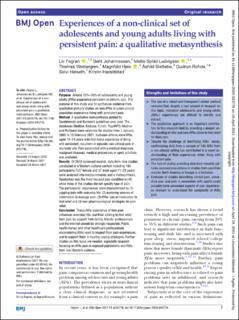| dc.contributor.author | Fegran, Liv | |
| dc.contributor.author | Johannessen, Berit | |
| dc.contributor.author | Ludvigsen, Mette Spliid | |
| dc.contributor.author | Westergren, Thomas | |
| dc.contributor.author | Høie, Magnhild | |
| dc.contributor.author | Slettebø, Åshild | |
| dc.contributor.author | Rohde, Gudrun Elin | |
| dc.contributor.author | Helseth, Sølvi | |
| dc.contributor.author | Haraldstad, Kristin | |
| dc.date.accessioned | 2021-05-20T10:30:56Z | |
| dc.date.available | 2021-05-20T10:30:56Z | |
| dc.date.created | 2021-04-23T08:36:54Z | |
| dc.date.issued | 2021-04-19 | |
| dc.identifier.citation | BMJ Open. 2021, 11 (4), 1-13). | en_US |
| dc.identifier.issn | 2044-6055 | |
| dc.identifier.uri | https://hdl.handle.net/11250/2755831 | |
| dc.description.abstract | Purpose Around 15%–30% of adolescents and young adults (AYAs) experience persistent or chronic pain. The purpose of this study was to synthesise evidence from qualitative primary studies on how AYAs in a non-clinical population experience living with persistent pain.
Method A qualitative metasynthesis guided by Sandelowski and Barroso’s guidelines was used. The databases Medline, Embase, Cinahl, PsycINFO, Mednar and ProQuest were searched for studies from 1 January 2005 to 15 February 2021. Inclusion criteria were AYAs aged 13–24 years with first-hand experience of living with persistent, recurrent or episodic non-clinical pain in any body site. Pain associated with a medical diagnosis, malignant diseases, medical procedures or sport activities was excluded.
Results Of 2618 screened records, data from nine studies conducted in a Western cultural context including 184 participants (127 female and 57 male aged 11–28 years) were analysed into metasummaries and a metasynthesis. Headaches was the most focused pain condition (n=5), while three of the studies did not specify type of pain.
The participants’ experiences were characterised by (1) juggling pain with everyday life; (2) exploring sources of information to manage pain; (3) AYAs’ use of medication to find relief and (4) non-pharmacological strategies for pain relief.
Conclusion These AYAs experience of how pain influences everyday life, and their striving to find relief from pain by support from family, friends, professionals and the Internet should be strongly respected. Public health nurses and other healthcare professionals encountering AYAs need to respect their pain experiences, and to support them in healthy coping strategies. Further studies on this issue are needed, especially research focusing on AYAs pain in exposed populations and AYAs from non-Western cultures. | en_US |
| dc.language.iso | eng | en_US |
| dc.publisher | BMJ Publishing Group | en_US |
| dc.relation.ispartofseries | BMJ Open;Volume 11, Issue 4 | |
| dc.rights | Navngivelse-Ikkekommersiell 4.0 Internasjonal | * |
| dc.rights.uri | http://creativecommons.org/licenses/by-nc/4.0/deed.no | * |
| dc.subject | Adolescents | en_US |
| dc.subject | Young adults | en_US |
| dc.subject | Persistent pains | en_US |
| dc.subject | Qualitative metasynthesis | en_US |
| dc.subject | Chronic pains | en_US |
| dc.title | Experiences of a non-clinical set ofadolescents and young adults living with persistent pain: a qualitative metasynthesis | en_US |
| dc.type | Peer reviewed | en_US |
| dc.type | Journal article | en_US |
| dc.description.version | publishedVersion | en_US |
| dc.rights.holder | Author(s) (or their employer(s)). | en_US |
| dc.source.articlenumber | 043776 | en_US |
| cristin.ispublished | true | |
| cristin.fulltext | original | |
| cristin.fulltext | original | |
| cristin.qualitycode | 1 | |
| dc.identifier.doi | http://dx.doi.org/10.1136/bmjopen-2020-043776 | |
| dc.identifier.cristin | 1905948 | |
| dc.source.journal | BMJ Open | en_US |
| dc.source.volume | 11 | en_US |
| dc.source.issue | 4 | en_US |
| dc.source.pagenumber | 13 | en_US |
| dc.subject.nsi | VDP::Sykepleievitenskap: 808 | en_US |
| dc.subject.nsi | VDP::Nursing science: 808 | en_US |

